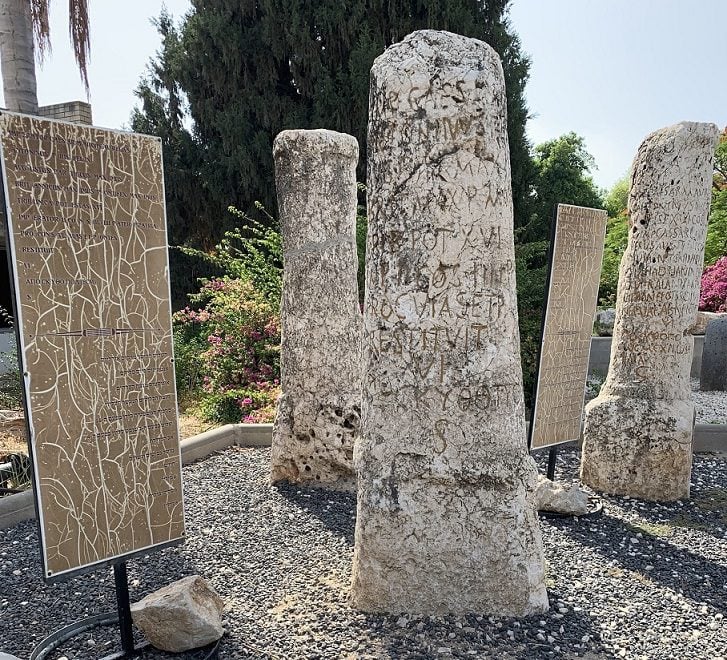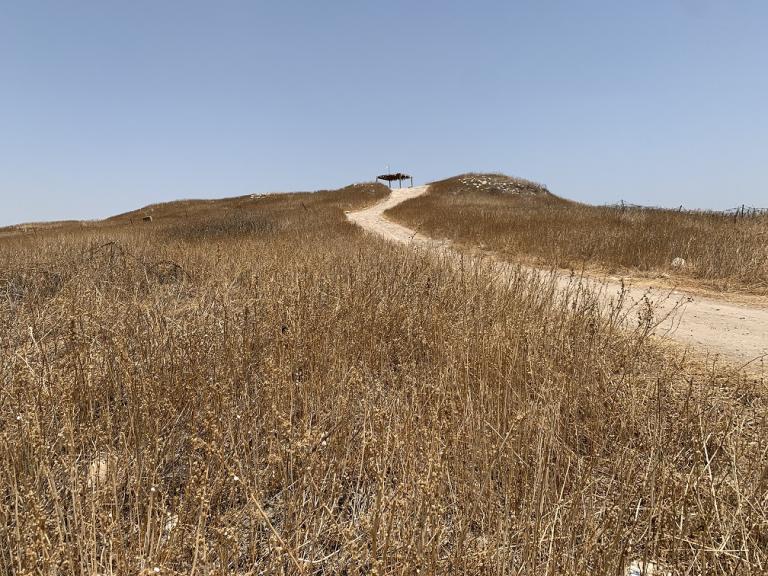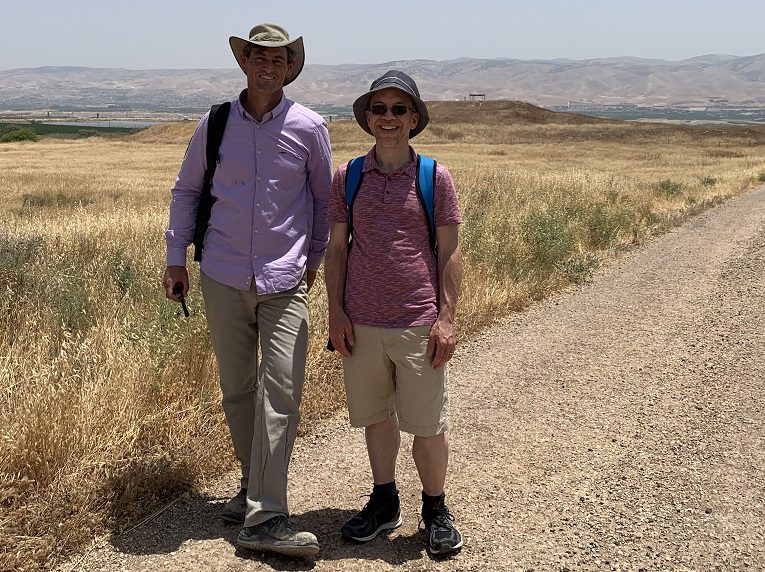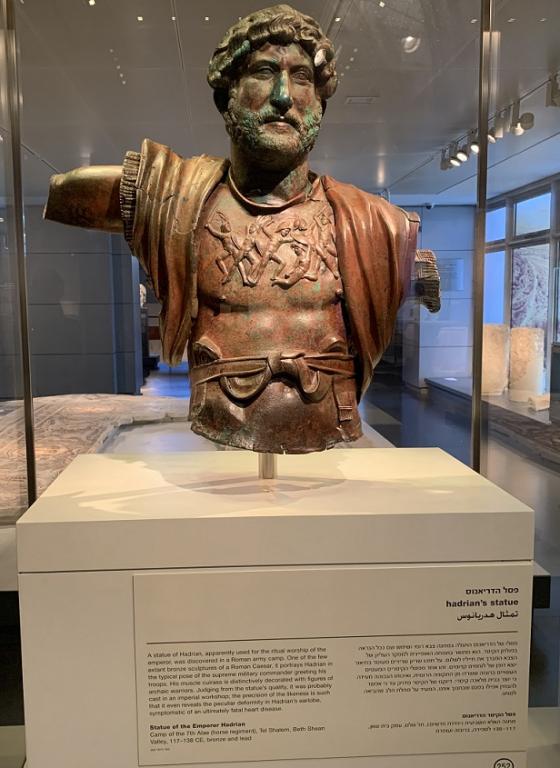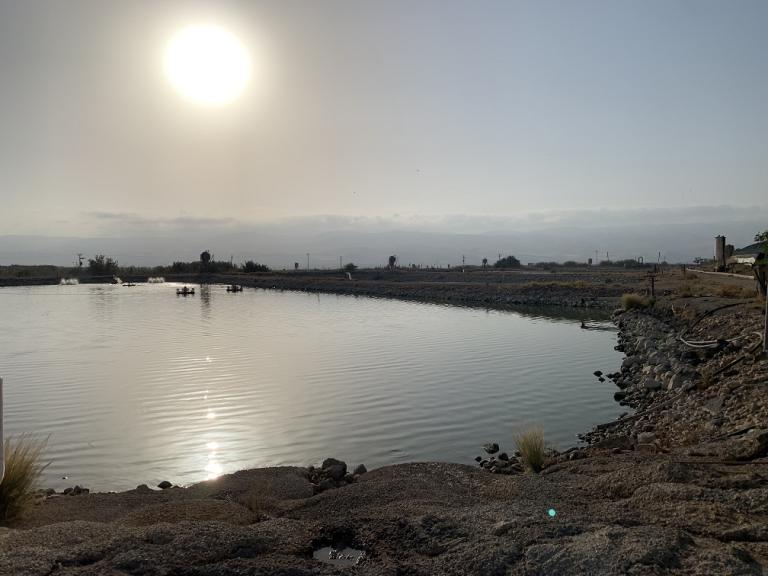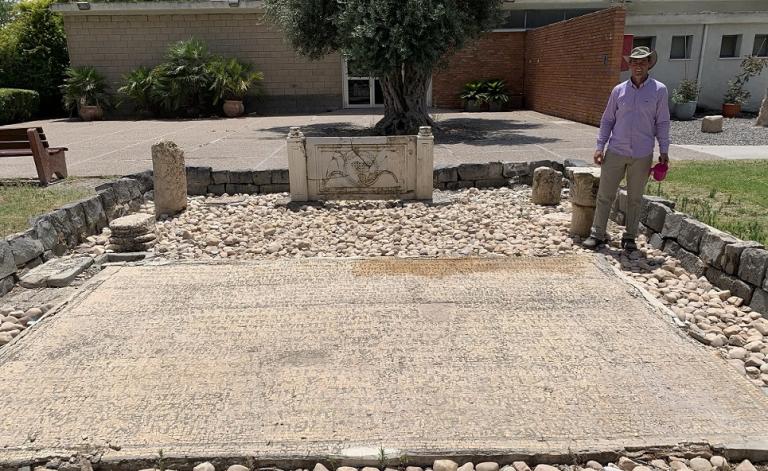James McGrath has recently traveled to Israel to walk in the footsteps of John the Baptist. I thought it might be of interest that we journey with James as well to discover the early days of Jesus' ministry through his cousin John. Enjoy.R.E. SlaterAugust 25, 2022PS - Here, James points out that God cannot act without us. I speak to this all the time, but contrary to my past evangelic faith (I am now a process-based post-evangelic re process theology), today's church deems such "action-readiness" to be militancy to society - among other cultural baggage.Which may have been John the Baptist's intention, if not the assumption of the author of Revelation, however I would like to take my cue from Jesus instead of from the church's "Just War theories." That is, Jesus taught love, lived love, and allowed himself to be executed because of his teachings on love and resistance to all other forms of religious zealotry.Hence the many articles here at Relevancy22 speaking to "Christian Humanism" - which was the old church term for Christianity in actionable service ministries to the community at large.Other equivalent terms today would be "Social Justice," "Ecological Restoration/Justice," building "EcoSocieties & Supportive Socio-Politico Economies," and eccetera." This, to me, would be the "biblical" way of reading John the Baptist, and later, Jesus' actions of preparing his followers/disciples for "Kingdom fitness."In terms of today's language the kingdom of God might be better thought of as a Commonwealth of God's people living in united solidarity with God in ministrations of love, mercy, forgiveness, resistance to lies and evil, and acting humanely in humanitarian mission to the world about itself. But not militancy, speaking wrath and condemnation upon the world. There is no ability to minister to others when we choose to ostracize ourselves from the world, or live in exclusion from the world in out own little theological bubbles.AmenR.E. SlaterAugust 25, 2022
In the Footsteps of John the BaptistExperiential Learning: The Axe is at the Root of the Treeby James F. McGrathJuly 21, 2022I blogged previously about what I learned about cherry-picking from the Bible by actually picking cherries. Today I’ll do something similar in relation to words attributed to John the Baptist in Luke 3:9 and Matthew 3:10. John says the ax is already at the root of the tree, and unfruitful trees will be cut down. You may consider this part of my series “in the footsteps of John the Baptist” although this insight occurred as I was working in my own garden, seeking to bring down a very small and recent tree that was growing at an angle and in a location that together posed the potential for problems later on. This work was relatively easy but not without effort being involved even so. This was much, much less strenuous than the process of bringing down a larger tree. We have some experience with that, but not doing the work ourselves. When there’s a large old tree near one’s house, sooner or later it will either be cut down or will fall and damage the house. We decided not to wait and hired a company. We did not pay extra to have the stump removed when we’ve had this work done, and such stumps are still there. I cannot help thinking about that in relation to John’s mention of the axe being at the root of the tree. I can’t make much of a dent in a large maple stump with a chain saw, never mind an axe.My main takeaway from thinking about John the Baptist while working in my yard is that I am even less persuaded that John’s apocalyptic vision was of God intervening to bring about change without human assistance. If the “one who is to come” was a person, someone who was to arise from within his circle of followers, and not a reference to God (as seems likely to me, although interpreters disagree about this) then John was preparing his group to bring about judgment and radical change, not merely to witness it as God did all the work miraculously. There would likely be a miraculous sign of some dramatic sort to confirm that the time had arrived. But people would need to prepare for that moment, and they would need to act when it arrived.This may be the reason for John’s question as to whether Jesus was this figure. I do get the impression that (i) John viewed Jesus as his right-hand man and likely successor in the movement at some point. I also get the impression that (ii) John began to doubt his earlier thinking about Jesus, most likely because Jesus was not enacting the kind of judgment that John preached about and was hoping for. Jesus took up John’s imagery of bearing fruit, but does not appear to have used it in precisely the same way or with precisely the same implications as his mentor.These are the kinds of things I think about as a New Testament scholar when working in the yard. I imagine that some people will do yard work hoping to put their jobs out of their minds for a while. I’m happy to have the privilege of a job in which I do what I love, and I think about the questions that I research as part of my job all the time and not just during regular business hours.What are your thoughts on John’s reference to the axe being at the root of the tree?In another instance of online serendipity, Steve Wiggins also blogged about trees:So did Brent Nongbri—more specifically about dendrochronology:Also check out James Tabor’s new video about the likelihood that the original version of the Book of Revelation was a Jewish, non-Christian work.See as well his follow-up blog post responding to an early response to his video…
In this interview with Derek Lambert, host of Youtube's #mythvision podcast, I discuss my work on restoring a pre-Christian version of the now very "Christian" book of Revelation that millions of Christians to this day reply on for their main eschatological interpretations.As it turns out, it is very likely that we are able to do that by a carefully analysis of what appear to be later interpolations--likely inserted toward the end of the 1st. century CE.In addition to this introductory video you can also access a full presentation and analysis, free of charge on-line, along with a sample of what the book might have looked like before the Christian scribes got hold of it. If this thesis has validity we would have here one of our earliest and only 1st century Jewish documents written before the destruction of Jerusalem by the Romans, as an interpretation of Daniel 7-11, likely circulating during the reign of the emperor Nero!Here are the links to the supplementary materials:
- https://jamestabor.com/here-it-is-at-...
- *If the second link does not immediately load the PDF of the restoring document, refresh your browser.
- Tabor Books: https://www.amazon.com/James-D-Tabor/...
- Academic Blog: https://jamestabor.com
James Tabor
James Daniel Tabor (born 1946 in Texas) retired in 2022 as a Biblical scholar and Professor of Ancient Judaism and Early Christianity in the Department of Religious Studies at the University of North Carolina at Charlotte,where he taught since 1989 and served as Chair from 2004–14. He previously held positions at Ambassador College (1968–70 while a student at Pepperdine University), the University of Notre Dame (1979–85), and the College of William and Mary (1985–89). Tabor is the founder and director of the Original Bible Project, a non-profit organisation aimed to produce a re-ordered new translation of the Bible in English.[1]
Background
Tabor was born in Texas but lived all over the world as the son of an Air Force officer. He was raised in the Churches of Christ and attended Abilene Christian University, where he earned his B.A. degree in Koine Greek and Bible. While earning his M.A. from Pepperdine University he taught Greek and Hebrew part-time at Ambassador College, founded by Herbert W. Armstrong, founder and president of the Worldwide Church of God.
Tabor earned his PhD at the University of Chicago in 1981 in New Testament and Early Christian literature, with an emphasis on the origins of Christianity and ancient Judaism, including the Dead Sea Scrolls, John the Baptist, Jesus, James the Just, and Paul the Apostle. The author of six books and over 50 articles, Tabor is frequently consulted by the media on these topics and has appeared on numerous television and radio programs.
During the Branch Davidian siege in Waco in 1993, Tabor and fellow religion scholar J. Phillip Arnold "realized that in order to deal with David Koresh, and to have any chance for a peaceful resolution of the Waco situation, one would have to understand and make use of these biblical texts." After contacting the FBI, they sent Koresh an alternative interpretation of the Book of Revelation which persuaded Koresh to leave the compound, though it was stormed by Federal forces first.[2]
Major publications and research
His first book was a study of the mysticism of the apostle Paul titled Things Unutterable (1986), based on his University of Chicago dissertation. The Journal of Religion named it one of the ten best scholarly studies on Paul of the 1980s.[citation needed]
In 1992 Tabor turned to an analysis of attitudes toward religious suicide and martyrdom in the ancient world, the results of which appeared as A Noble Death, published by HarperSanFrancisco in 1992 (co-authored with Arthur Droge). Tabor's book has been used as a standard by ethicists, lawyers, and physicians who are participating in the current debate.[citation needed] Tabor has also published a wide variety of scholarly and more popular articles in books, journals, and magazines.
In 1995, he published Why Waco? Cults and the Battle for Religious Freedom in America (University of California Press), which he co-authored with Eugene Gallagher, and which was one of the first books to explore what had actually happened during the Waco siege. In 1995 he testified before Congress as an expert witness on the siege.[citation needed]
The Jesus Dynasty
In 2006 Tabor published The Jesus Dynasty, which interprets Jesus as an apocalyptic Messiah whose extended family founded a royal dynasty in the days before the destruction of Jerusalem in 70 AD. The form of Christianity that grew out of this movement, led by the apostle Paul, was, according to Tabor, a decisive break with the Ebionite-like original teachings of John the Baptist and Jesus.
Richard Wightman Fox, Professor of History at the University of Southern California, writing in Slate (April 2006) said, "Ultimately Tabor leaves the reader confused about whether he thinks the Jesus dynasty is a historical fact or merely an intriguing conjecture" and that "Tabor seems stuck in an endless loop, squinting across the sands of time as much as the terrain of Galilee and Judea, holding out for some imagined "real" contact with the historical Jesus".[3]
An extensive popular review by Jay Tolson appeared in the April 9, 2006 issue of U.S. News & World Report.[4]
Bert Jan Lietaert Peerbolte from the Theological University of Kampen writing in the Society of Biblical Literature Review of Biblical Literature (June 2007) was highly critical of the book saying, "Some books are written to spread knowledge, others to generate controversy. This book falls into the latter category. In his Jesus Dynasty James Tabor presents a reconstruction of the Jesus movement from a perspective that purports to be a neutral view at the facts. Unfortunately, Tabor’s view is not neutral and his ‘facts’ are not facts."[5]
Jeffrey Bütz in The Secret Legacy of Jesus (2010), says that The Jesus Dynasty is "a long overdue and most welcome addition to our knowledge of the historical Jesus, which has, not surprisingly, been widely denigrated by conservative scholars."[6]
Other activities
Tabor serves as Chief Editor of the Original Bible Project, an effort to produce a historical-linguistic translation of the Bible with notes.
Tabor has been involved in research on a tomb found in 1980 in Jerusalem in the area of east Talpiot. It contained ossuaries with the names Jesus son of Joseph, two Marys, a Joseph, a Matthew, and a Jude son of Jesus. In the book, The Jesus Dynasty, Tabor had discussed the possibilities that this tomb might be linked to Jesus of Nazareth and his family. He was a consultant for the film, The Lost Tomb of Jesus produced by James Cameron and Simcha Jacobovici and shown in March 2007. In 2012 Tabor published, with co-author Simcha Jacobovici, The Jesus Discovery: The New Archaeological Find That Reveals the Birth of Christianity (Simon & Schuster), which documents the recent exploration of a sealed tomb by remote robotic cameras, less than 200 feet from the first tomb.
Tabor has also appeared several times in all 3 seasons of The Naked Archaeologist, with Simcha Jacobovici.
Tabor's works are promoted by the educational charity United Israel World Union. He co-hosts tours of the Holy Land which are conducted by this organization.[7]
Controversial Views
In 2012, using a robot arm with a mounted camera, James Tabor explored a Second Temple-era burial cave in Armon Hanatziv along with the controversial film-maker Simcha Jacobovici. They claimed that the 2,000-year-old cave might be the burial site of Jesus's disciples - a claim which the majority of scholars reject.[8][9]
Books
- Paul and Jesus: How the Apostle Transformed Christianity, Simon & Schuster, 2012, ISBN 978-1-4391-2331-7
- The Jesus Discovery: The New Archaeological Find That Reveals the Birth of Christianity (with Simcha Jacobovici), Simon & Schuster, 2012, ISBN 978-1-4516-5040-2
- The Jesus Dynasty: A New Historical Investigation of Jesus, His Royal Family, and the Birth of Christianity, Simon & Schuster, 2006, ISBN 0-7432-8723-1 & ISBN 0-00-722058-8
- Invitation to the Old Testament (with Celia Brewer Sinclair), 2005, ISBN 0-687-49590-3
- Why Waco?: Cults and the Battle for Religious Freedom in America (with Eugene V. Gallagher), 1995, ISBN 0-520-20899-4
- A Noble Death: Suicide and Martyrdom Among Christians and Jews in Antiquity (with Arthur J Droge), 1992, ISBN 0-06-062095-1
- Things Unutterable: Paul's Ascent to Paradise in Its Graeco-Roman, Judaic and Early Christian Contexts, 1986, ISBN 0-8191-5643-4 & ISBN 0-8191-5644-2 (based on Tabor's University of Chicago dissertation. Named by the Journal of Religion as one of the ten best scholarly studies on Paul of the 1980s.[10])
References
- ^ "Introducing the Transparent English Bible". Transparent English Bible. Original Bible Project. 2018.
- ^ Gladwell, Malcolm (March 31, 2014). "Sacred and Profane: How not to negotiate with believers". The New Yorker. Retrieved 2 May 2014.
- ^ Wightman Fox, Richard (April 13, 2006). "Jesus Nation". Slate. The Washington Post. p. 1. Retrieved 10 October 2010.
- ^ Tolson, Jay (April 9, 2006). "The Kingdom of Christ". US News & World Report. Archived from the original on 12 November 2009. Retrieved October 10, 2010.
- ^ Jan Lietaert Peerbolte, Bert (2007-06-23). "The Jesus Dynasty". Society of Biblical Literature. p. 1. Retrieved 10 October 2010.
- ^ Jeffrey Butz, The Secret Legacy of Jesus, ISBN 978-1-59477-307-5, p. 24.
- ^ Tabor & Nichols Israel Tour March 2021 – Walking the Ancient Paths
- ^ Hasson, Nir. "'Naked Archaeologist' Finds Signs Jerusalem Cave Was Used to Bury Jesus' Disciples". Haaretz. Retrieved 23 May 2022.
- ^ Boyle, Alan. "Doubts about 'the Jesus Discovery'". NBC News. Retrieved 23 May 2022.
- ^ "The Jewish Roman World of Jesus". The Jewish Roman World of Jesus.
External links
- TaborBlog
- The Jewish Roman World of Jesus
- The Jesus Discovery research
- The Jesus Discovery book
- The Jesus Dynasty
- The Original Bible Project
- Article by Dr. Tabor at the Society of Biblical Literature on the Talpiot Tomb
- Letter to the Editor of SBL by Dr. Tabor
- James Tabor at IMDb
- Interview with Professor Kloner which discusses James Tabor


